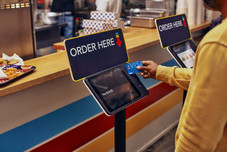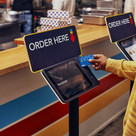Soon, we’ll use a new type of credit card here in the U.S., one that’s embedded with a tiny microchip. These chip cards (also known as EMV cards) are iron-clad against counterfeiting — something that can’t be said for the magnetic-stripe cards we currently carry.
Chip cards are processed differently — they’re dipped instead of swiped — which means we’ll need new payment terminals to read them. Aside from protecting against fraud, these new processors will also pave the way for the next step in payments: mobile, contactless transactions.
Chip cards are pretty cool, but they’re not anything new. Nearly every major economic region outside of the United States already uses chip cards. In fact, chip technology has been around since the ’80s and has been the standard in some countries like the UK for over a decade. According to a report by payment processing company First Data, it’s now estimated that 70 percent of non-U.S. credit card terminals are chip card—enabled.
Chip cards have proven to be super effective in fighting fraud abroad. They’ve been particularly successful in Europe, where roughly 90 percent of credit card terminals are now EMV-enabled. The UK, for example, has seen a nearly 70 percent decline in counterfeit card transactions since adopting chip cards, according to Barclays. Similarly, in Canada, research firm Aite Group reports that losses from counterfeit, lost, and stolen cards dropped from 245 million Canadian dollars in 2008 to 111 million in 2013.
On the other hand, credit card fraud is trending way up in the U.S. We lost over 5.3 billion dollars to credit card fraud in 2013, up 14.5 percent since 2012, according to a Nilson report. And here’s something even crazier: Half of the world’s credit card fraud happens in the United States, even though only a quarter of all credit card transactions happen here. A primary culprit? Fraudsters who can’t hack chip cards and are now turning their efforts to the U.S.
It seems like a no-brainer to make the switch. So what’s been holding things up? The biggest reason is cost. Switching out all our cards and payment processing systems — think ATMs, registers, vending machines, self-service kiosks, ticket terminals — will cost anywhere between 8 billion and 12 billion dollars.
But now we’re investing. Recent high-profile security breaches (like Home Depot, Target, and Neiman Marcus), along with the increasing difficulty in paying with magnetic-stripe cards overseas, have pushed things onto the fast track. So if you haven’t already received a chip card from your bank, chances are you’ll get one in the mail before next October.
What does all this mean for merchants? The long and the short of it is that you’ll need a new processing device to read chip cards. This may seem daunting and expensive, but Square’s here to help. We’re building affordable solutions so you’re set up to process chip cards, and soon, contactless transactions. Click here to learn more about Square’s forthcoming chip card products and here to learn more about what the EMV migration means for you and your business.
![]()












